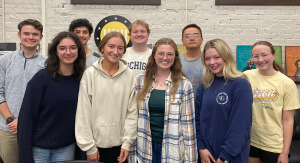
An important piece of Missouri history, the Santa Fe Trail connected the Show-Me State to present day Santa Fe, New Mexico, providing a valuable trade route through the middle of a still growing United States. The trail has been of interest to historians in the Kinder Institute on Constitutional Democracy – and a new research project will now allow undergraduate students at the University of Missouri to excavate historical data related to the trail.
Through the ASH Scholars Program, the Santa Fe Trail research team will not only dive into the importance of the trail, but they will also share their findings with public audiences.
“This was a formative time in Missouri’s history,” said Jay Sexton, the Rich and Nancy Kinder Chair of Constitutional Democracy, professor of history and director of the Kinder Institute. Sexton is also one of the faculty leads for the Santa Fe Trail team. “The trail was inaugurated around the same time that Missouri became a state, in 1821. So, this is not only a story of Missouri integrating into the United States, but also a story of people and markets integrating across a growing country.”
Santa Fe Trail is the newest of five research projects within the ASH Scholars Program, which includes research teams based in the arts, social sciences and humanities (ASH) disciplines. ASH Scholars receive a $3,000 scholarship, disbursed in four equal parts over the academic year.
The ASH Scholars Program is a collaboration between the Honors College and the MU Office of Undergraduate Research. While the Honors College plays an important role in the program, students do not have to be pursuing the Honors Certificate to participate. Students of all academic majors and grade levels are invited to get involved.
“It’s great that we have the opportunity to empower our students with a project of this nature,” Sexton said. “We want our students to have the freedom to pursue the questions surrounding the Santa Fe Trail that they are interested in answering.”

Sexton is leading the team alongside Kyle Jackson, a Ph.D. candidate at the University of California, Berkeley, who is serving as a research fellow at Mizzou as he finishes his dissertation. Jackson came to Mizzou specifically to help oversee the project.
“I’m thrilled to be working on this project,” Jackson said. “I’m most excited to dive into history that I don’t know a ton about. It will be very rewarding to learn alongside the students as we help them develop good research skills and showcase how historians work on a day-to-day basis. My primary goal is to help give our undergraduates the tools to perform their own historical research with an eye toward making it accessible to the public.”
Covering approximately 900 miles, the trail lasted about 60 years in its official capacity. The trail was not only important for traders, but it also served as a route for early pioneers and America’s military. It also played an important role in westward expansion.
While the completion of the Santa Fe railroad lessened the use of the Santa Fe Trail, Sexton said they are interested in studying how the route has shaped current landscapes.
“When we think about the Santa Fe Trail, we generally think about mule-led covered wagons,” Sexton said. “That was actually a pretty short period when you look at the trail historically. What was the trail eventually became a road, which became a railroad and then a highway. We’re not looking at just one moment on the trail – we’re studying its entire history. Our present is very connected to the past. The trail shaped settlement patterns. It affected wildlife and the environment along the route. Everything combines into this incredible story.”
The trail was established just 30 miles west of Columbia, around the town of Franklin, Missouri. The research team is planning on tapping into the local history of the trail with the goal of eventually producing a student-driven podcast.
“We want to connect our students with the history that’s all around them,” Jackson said. “They are going to have an opportunity to engage with this local history and share their findings in a unique way. Producing a research paper is great, but we also want the students to have something to really connect to. We want to meet the public where they’re at, too. This is a long-term research project, so we want to keep that energy going throughout the different phases of the work.”
Students will work with local history associations to expand their knowledge of the trail. There is a similar team of graduate student researchers at the University of New Mexico doing research on the trail, too. Jackson said they have plans to meet with that group at some point, as well as bring in guest speakers and other historians.
“The undergraduate students who get these types of research opportunities often get hooked on this type of work,” Jackson said. “They realize that there’s more to being a historian than just reading other people’s books and trying to recapitulate that information. Historians love grappling with primary sources – and we’re giving the students the opportunity to go out and find those sources. There’s excitement in weaving those together.
“Having a laboratory-style setting for the students is incredible. There’s so much intrinsic value in research. This is the kind of opportunity I would have loved as an undergrad.”